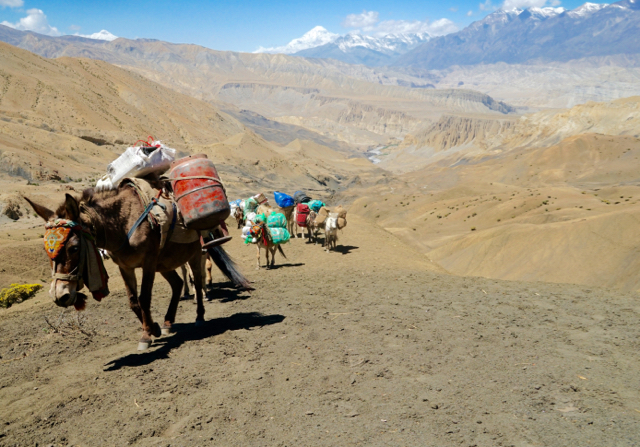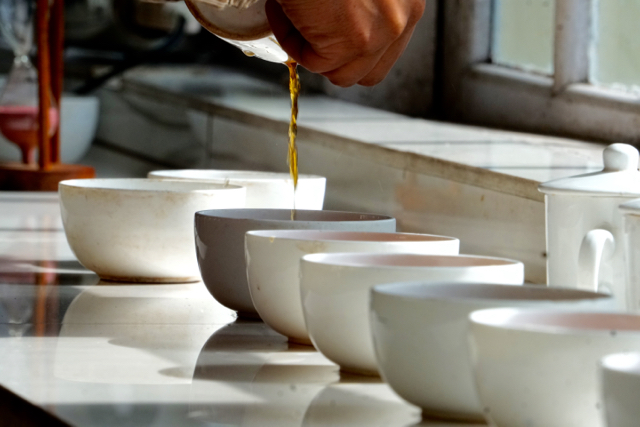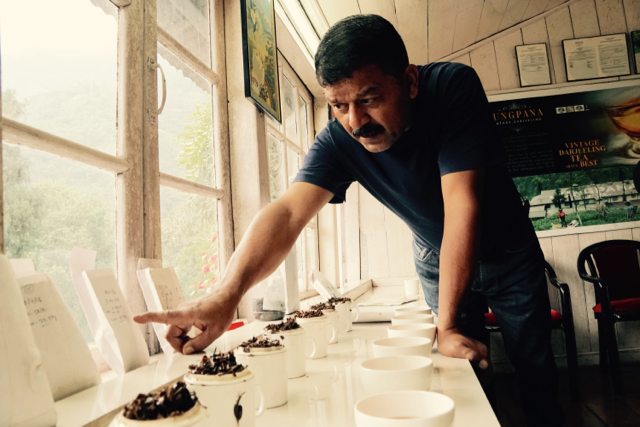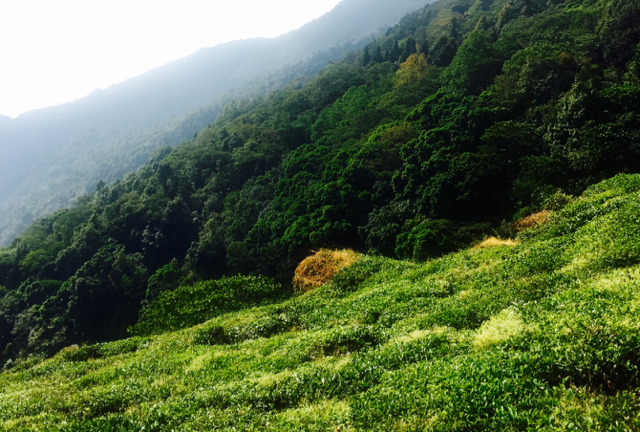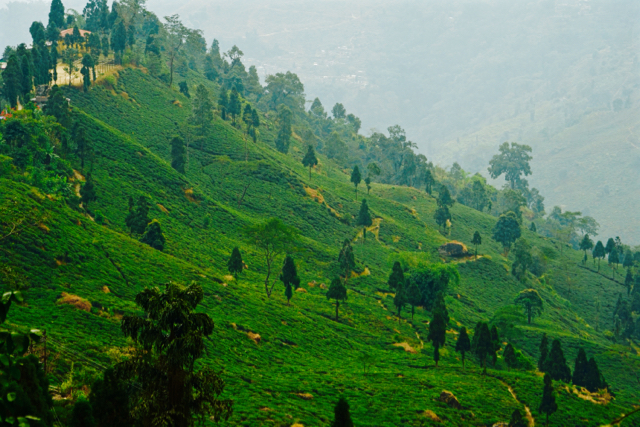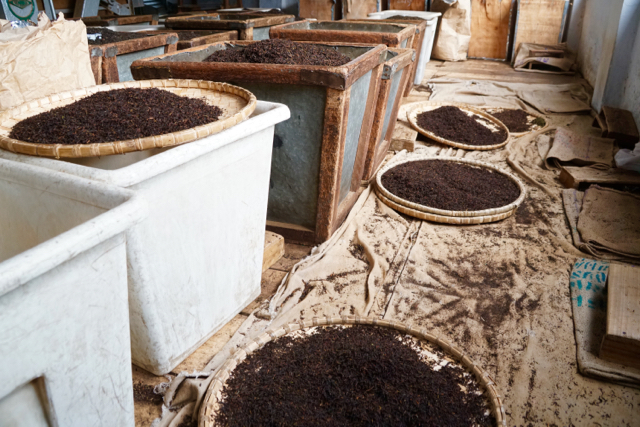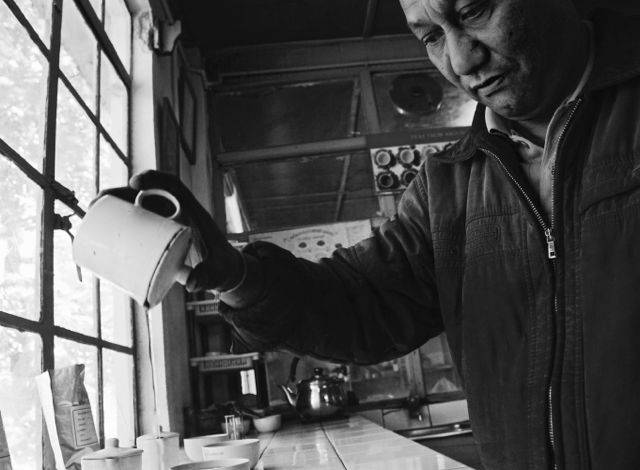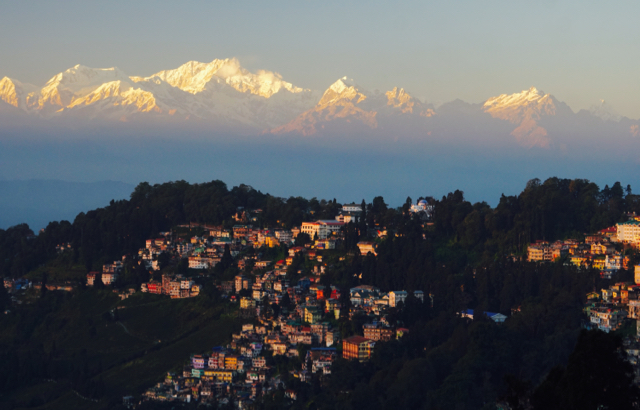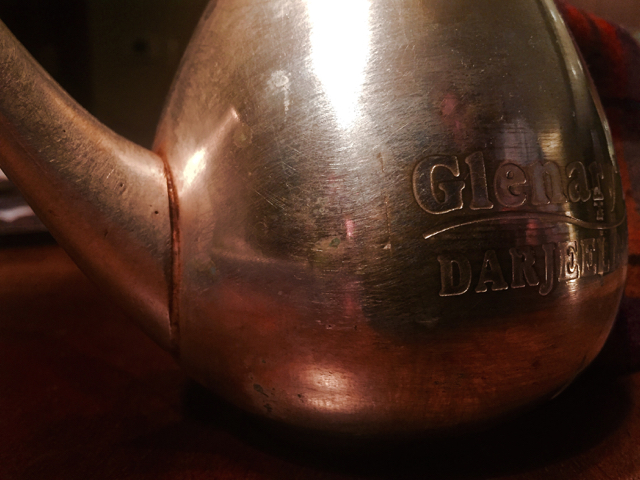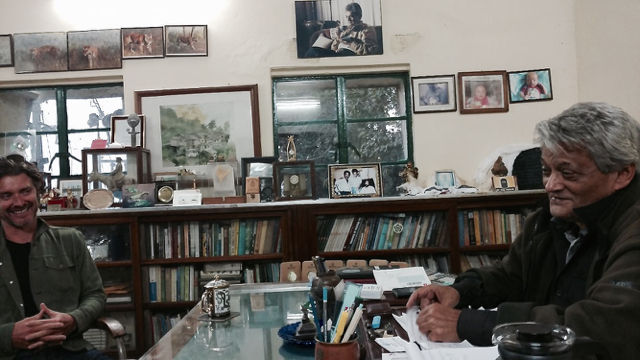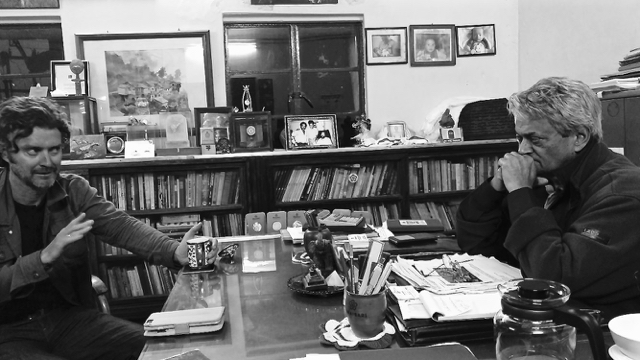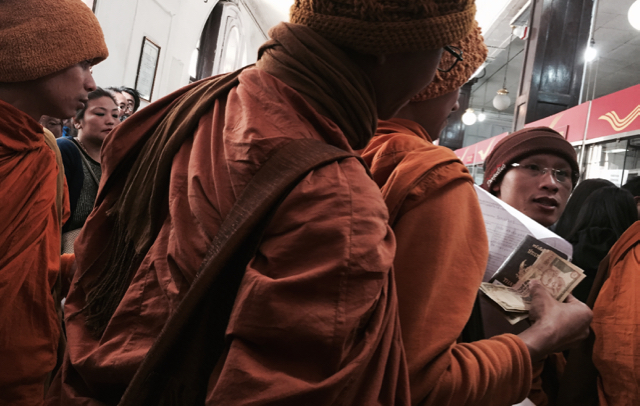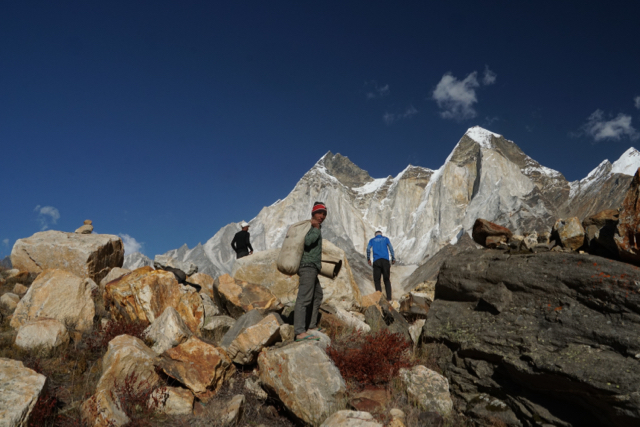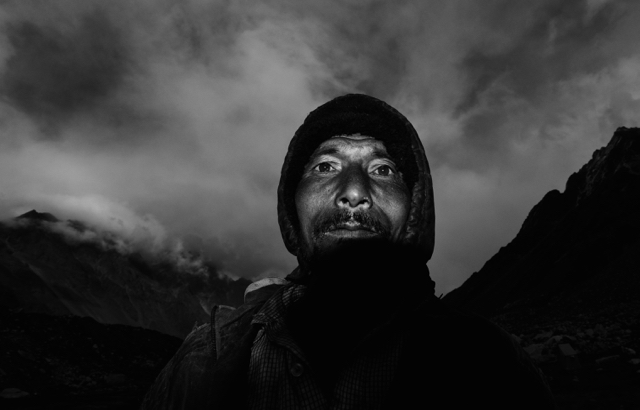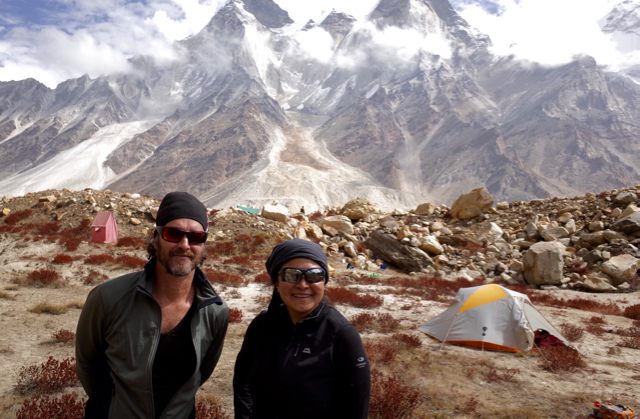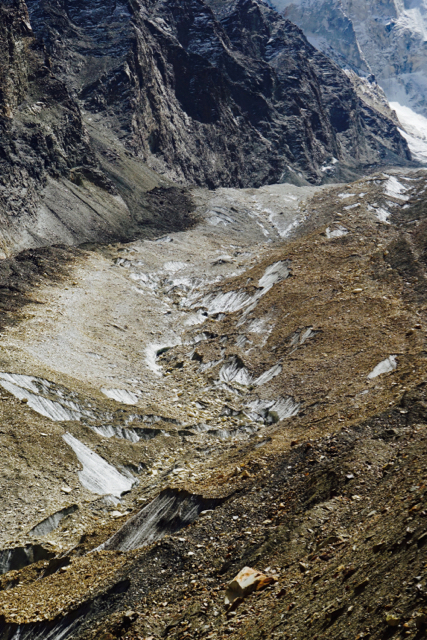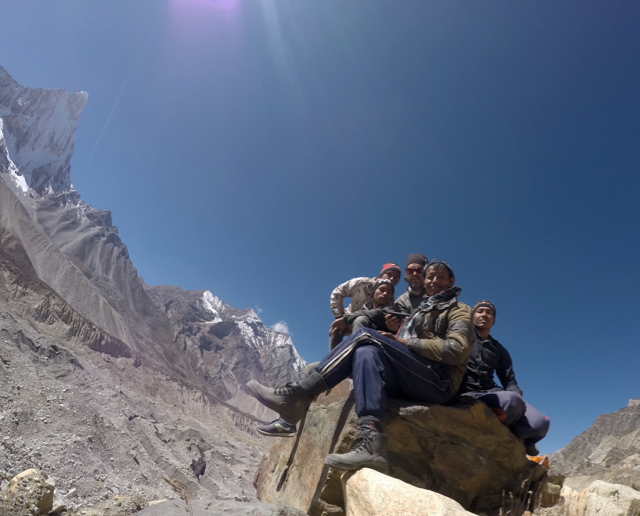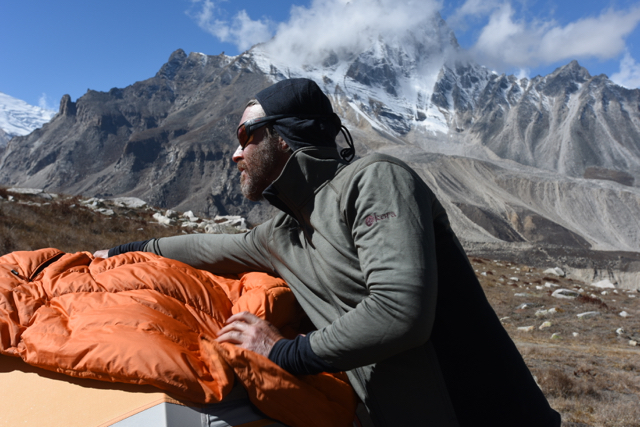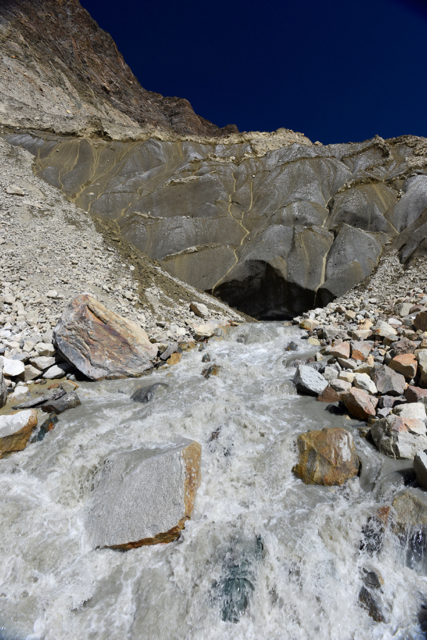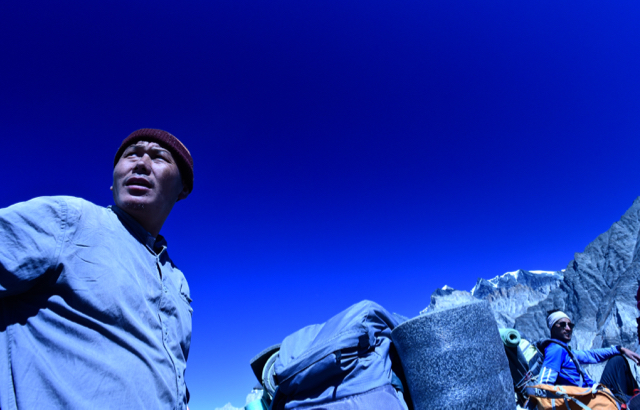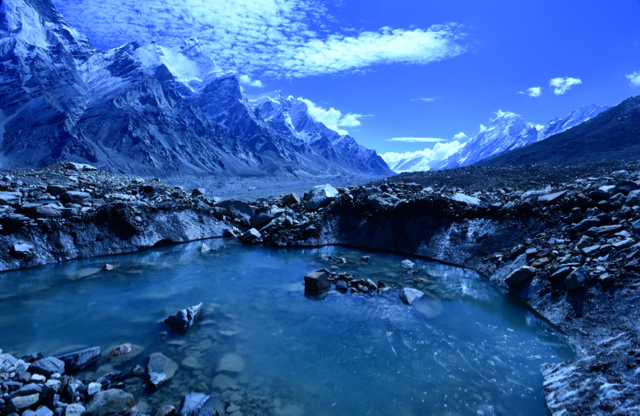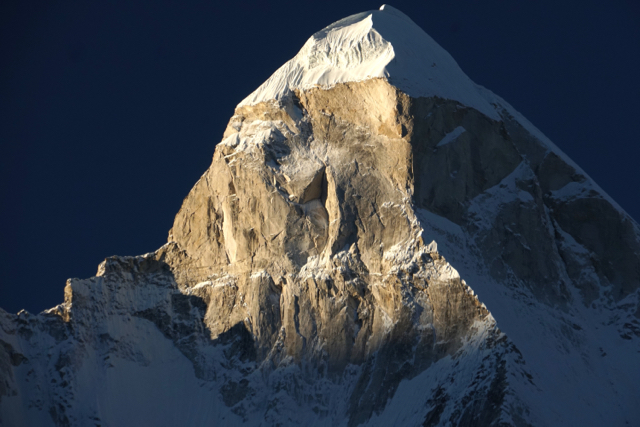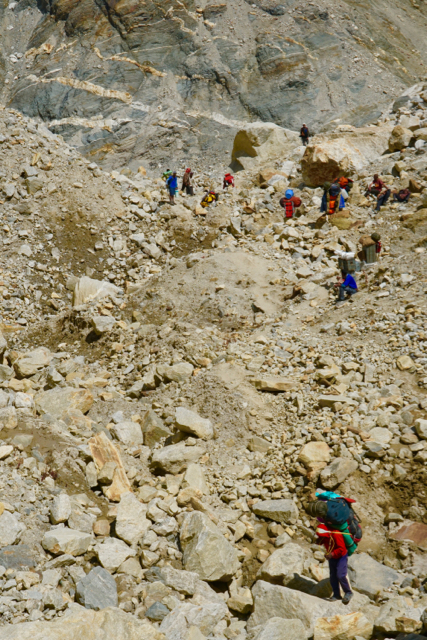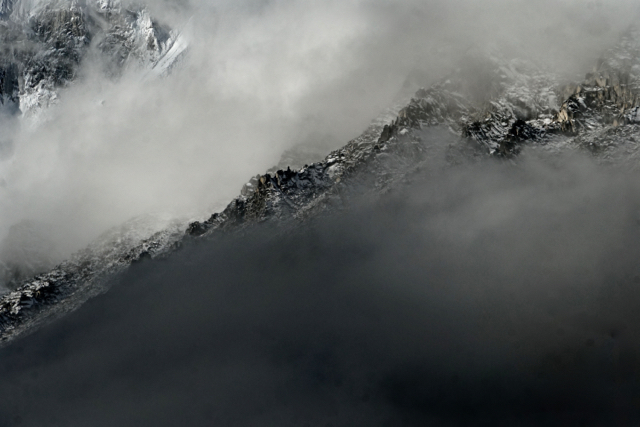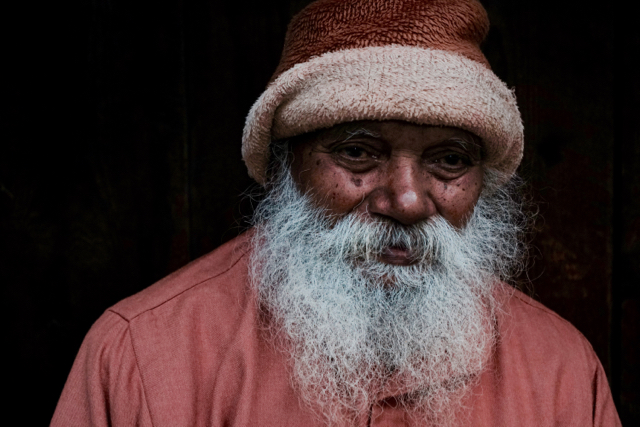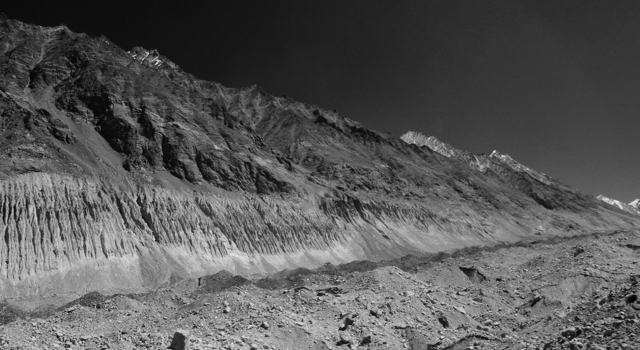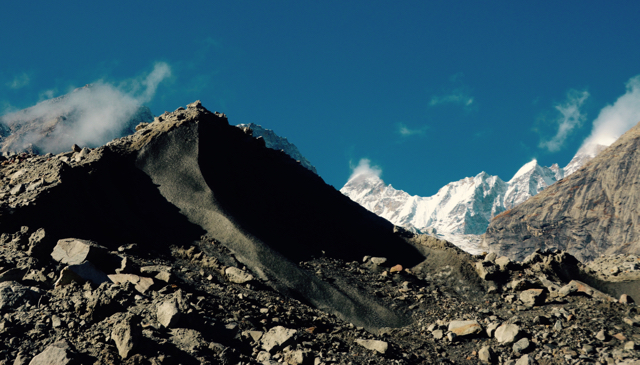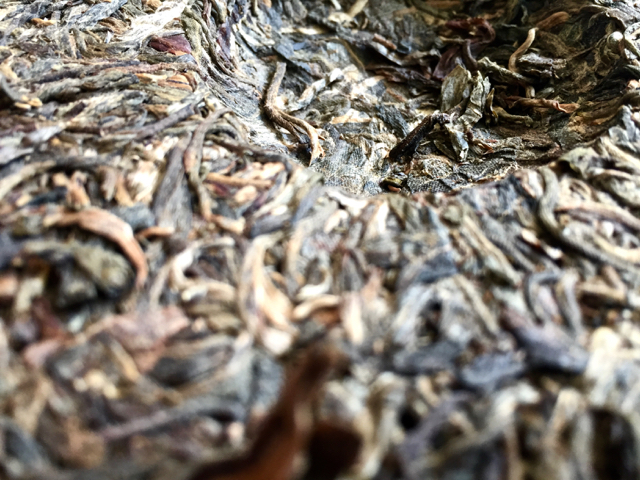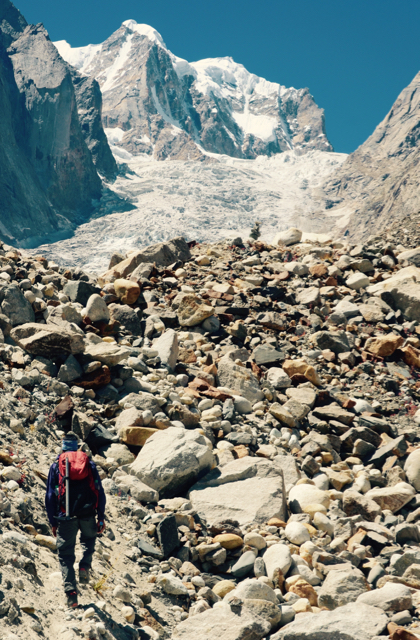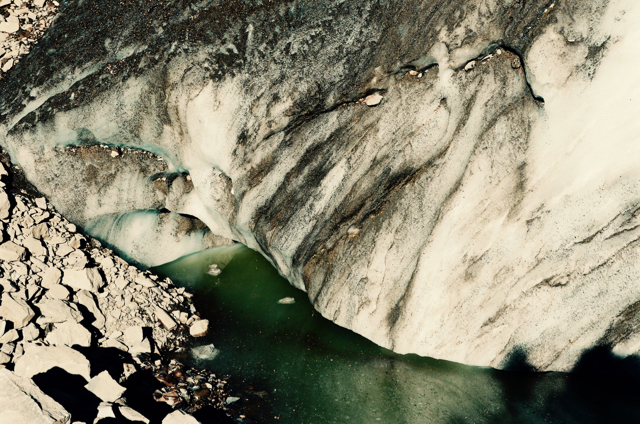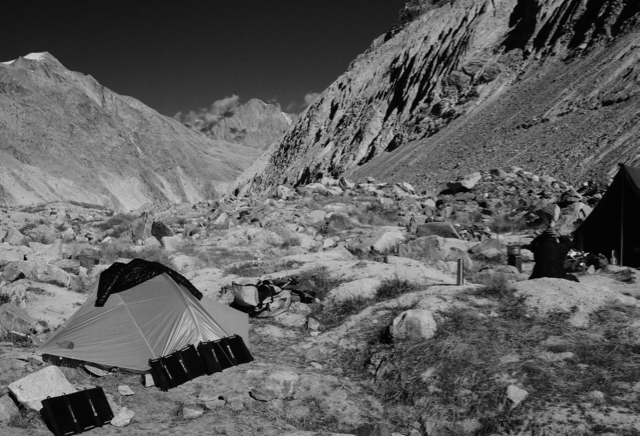Berinder is impatient and staring in his mournful way at Saurabh and I to hurry. He wants to move and it is our day to make another incursion into the Chaturangi Glacier valley and then head south up a smaller feed valley. The three of us for much of this journey have been a party of wanderers while others wait in base camp. Berinder has had his tea and stands like a shy gunslinger with hands at the side, ready.
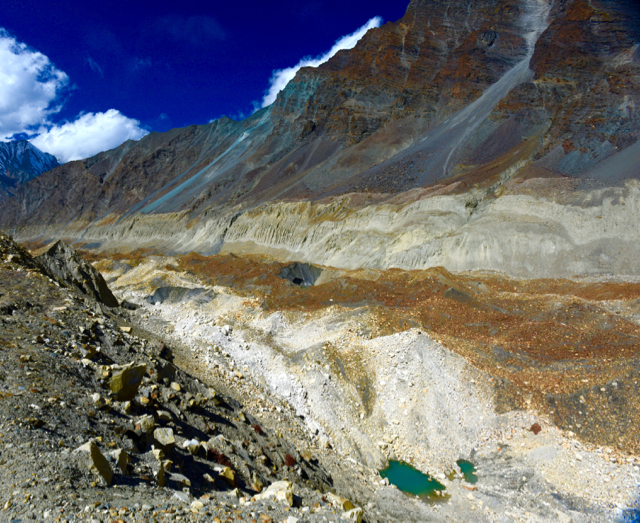
Some of the multi-hues of Chaturangi Glacier
We chug tea down in huge quantities and once again tea’s grip and binding power plays into the mountains’ spaces. Solitary geographies need mornings where tea, bodies, and the sun gather to usher in new light. Tea and mountains are, not for the first time, the perfect companions, fuel and inspiration.
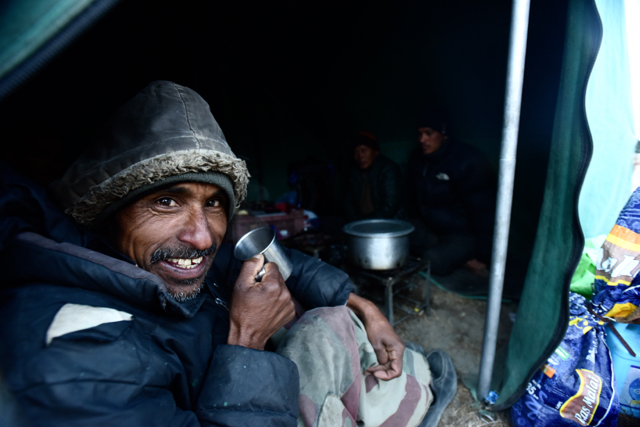
Every single break consists of tea passing through the lips
Nadanvan Camp sits at the end of the Chaturangi Glacier, a multi-hued length of ice, stone and moraine fused into layers. On this morning at there is a chatter as all of us stand waiting for the slow ascending sun to touch us and grace us with a bit of warmth. Morning chatter comes in two forms here with this team. One is what the day will hold for various members of our team. Laundry, playing cards in the tent, a lot of tea, or simply wandering for short walks around camp. The second subject of chatter usually begins with a ‘target’ of the day. Sometimes an incident, sometimes a person…whatever the cause, it will become a kind of point to return to throughout the day with humour, mirth and a little relentless ribbing.
Deb has continued to grind through each day and each new ascent in her simple and plodding way, and Purun is her faithful escort on every little blip, turn, and sip along the way – an honour guard of sorts to ensure that risks are kept to a minimum. He mentions several times with a smile (and faint look of pride) that “Deb is doing much better than last year” (a referral to another month-long expedition that tested Deb’s resilience to the extreme).
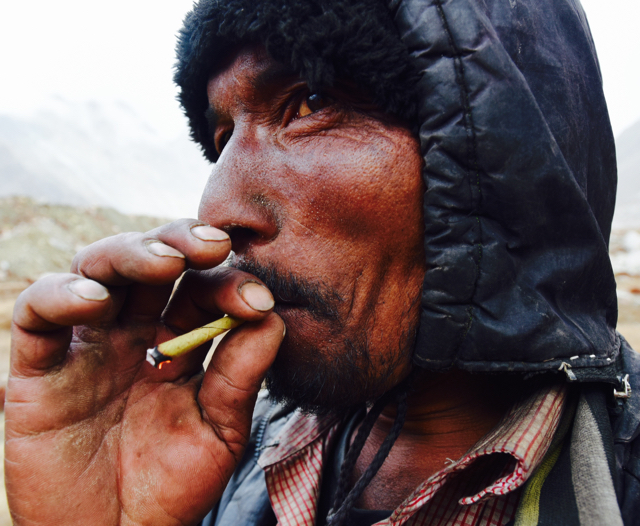
One of the few pleasures of the porters besides tea and companionship: the clove cigarette.
Once we have our packed lunches, Berinder is almost pleading in his looks at us. He gets his wish and we are off east into a sun that still has yet to settle into the shadowed lands of morning. As on most days that the three of us are together, there is little chat, and when there is, it is minimal and meaningful (at least to us). Comments and observations about weather, about what might be on the horizon, and about what we hope to see. Today, the object is simply to wander at will to a smaller tributary glacier.

Some of the views when one descends into the glaciers. These ice tunnels can span metres in width and travel for kilometres underfoot.
Berinder has the telltale odd-looking walk of someone who is used to hauling enormous loads, so watching him shuffle and almost levitate along the route is as much fun as it is looking down into the Chaturangi mottled toned glacier. Powerful beyond words, it as if Berinder doesn’t know what to do with all of his spare strength without the restraints of his strapped loads. Saurabh glides forward, and below us to the north red stone, green pockets of glacial ponds, and striating rock shelves and ice lie along the Chaturangi. The ‘little’ lakes and ponds below us are supraglacial lakes and can be far wider and much deeper than an interested set of eyes might suspect. They can also have a further warming effect on the glacier as they attract more of the sun’s warmth. Glacial Lake Outburst Floods are one of the possible results of such ‘lakes’, and the Himalayas entire span have tales of these vertical tsunamis that explode out of stunning coloured lakes.
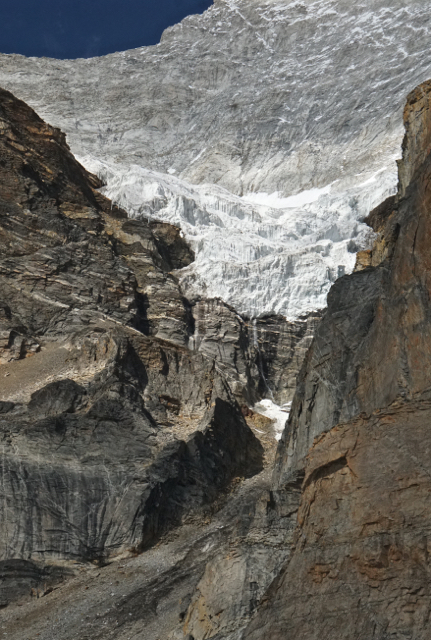
That which disappears. Smaller glaciers and tributary moraine flows often tell a more concrete story.
Packed light, Suarabh, Berinder and I are geared for speed and ease. Saurabh leads checking on us all with little peaks to see that we’re all still with him, though we are spread apart in a wide formation as each of us has learned that we all tend to weave and wander. The concern is that afternoon storms have made a habit of coming in with force. We are late in the season; the end of it really, and though the bolt-blue sky hints at nothing, the air currents do. Every few minutes a body of wind will carry sharper, colder air through the valley around us.
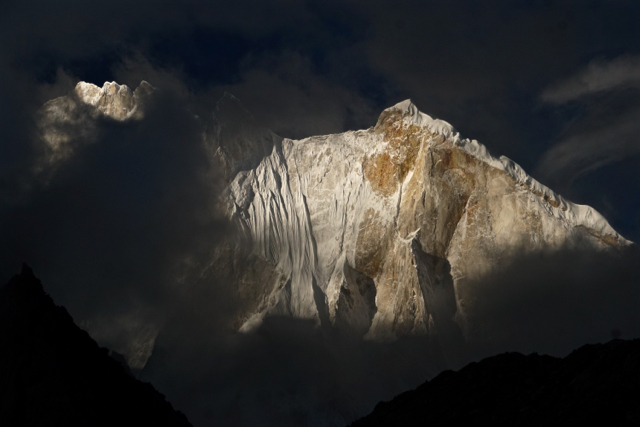
Meru’s headwall in early morning light from Nandanvan Camp
Above us to the right is Bhagirathi 2 peak and its 6512-metre chunk of summit. Travel with Berinder and Saurabh, and indeed the entire team, pushes home the idea that the altitude really doesn’t matter much beyond the normal restraints and limits that less oxygen bring. Sacred peaks, as it has long been explained to me, are living things to the locals. Forget this piece of information (regardless of one’s beliefs) and one is in peril; peril of taking oneself too seriously, peril of forgetting that the essence of the Himalayas rests in horizontal lines not the verticals, and peril too of simply getting caught up with numbers. In the Himalayas, practicality and the world of deities and goddesses is remarkably simple and collaborative. For locals they find little contradiction in the fusing of ‘facts’ with ‘beliefs’, and I love this about the world of heights. A scientist client years’ ago, had gently prodded and questioned a local guide about ‘facts’ and beliefs, and I worried the normally gentle, but immensely strong tracker and friend would tear a limb off of the city-dwelling doubter. In fact he just nodded at the questions and comments, looked at me (as if to say “watch while I maintain complete control”) and then stated simply, “It is interesting what you say and maybe true. What we think is also interesting and maybe true”. Beliefs inform living and in many cases locals I’ve encountered will point to their ‘ways’ as being more sustainable (though they rarely if ever use the word sustainable), and intuitive. They also point out often, that it was not their ways that brought about so much destructive and rapid change with the natural world, but rather the outside world of greed and speed.

A tributary glacier valley that feeds the Chaturangi
At one point – as the mountains frequently do with brilliant and often brutal power – the air changes entirely and there are suddenly tangs and whiffs of snow in the winds coming down from the Kalindi Pass further east of us. Winds pick up and the air that is blown in carries with it the unmistakable sharpness of lands and spaces higher up where the temperatures plunge.

Bishan and I slogging up, down, into and around some of the glacier’s space. Photo courtesy of Kapil Negi
Above, the skies are swirling as well with hints of grey. This also marks a point where Saurabh will head further on his own to assess what the conditions are. Berinder, our tea, some little bits of chocolate and some almonds will await his return.
After 25-minutes, with Saurabh having disappeared down a steep pathway only to ascend once again on a distant ridgeline, Berinder starts getting his now familiar look of furtive impatience. Try as he may along this journey, he has never been able to rest still for more than a few minutes, even when exhausted. His energy and force is remarkable. The storm continues to gather into the valley and now the sky is more grey than blue. We both lie on our stomachs chewing on nuts watching Saurabh’s tiny figure hurtles upward along little line of a pathway. The he simply disappears. Within minutes, Berinder is itching to go and follow motioning me with those dark pockets of eyes of his to move. He doesn’t even try to cover up his intentions or fears or whatever it is that is driving his passionate impatience. It has been the way for the entire month-long journey. The great thinker Seneca once said about passions that it was better to “make an exhibition of my passions than brodd over them to my cost: express them, vent them, and they grow weaker; it is better to let hem jab outside us than be runed against us”. (Seneca, Epist, moral., LVL, 10). It seems a fitting thought for Berinder who is unable to restrain himself. There are some little bits of English, a lot of bits of Nepali, some shakes of the head from me and some deep nods of the head from him. In the end, I relent and we scurry ourselves down to follow Saurabh’s path, and Berinder is content once again.
The valley we pass down into and out of is one of the reasons we have ultimately come. It is a stunning and hidden rivulet-lined sheet of concave ice that plunges towards the Chaturangi Glacier behind us. As a tributary glacier it is as vital a witness (and victim) to what ails the mountains as any river or mountain-top. Berinder hurries on with only little care doing moving quickly in little darting motions. He is driven to keep our unit together and to re-bond with Saurabh. The sooner we are three again, the better. For me the mountains are a place of divine isolation and that is part of the reason I return, whereas for many of the people who live and were born within the spires and valleys, the mountains are a place to find and adhere to a community. Berinder and I slow down at last and stop to take in more of this ice-body witness, that we are literally straddling.
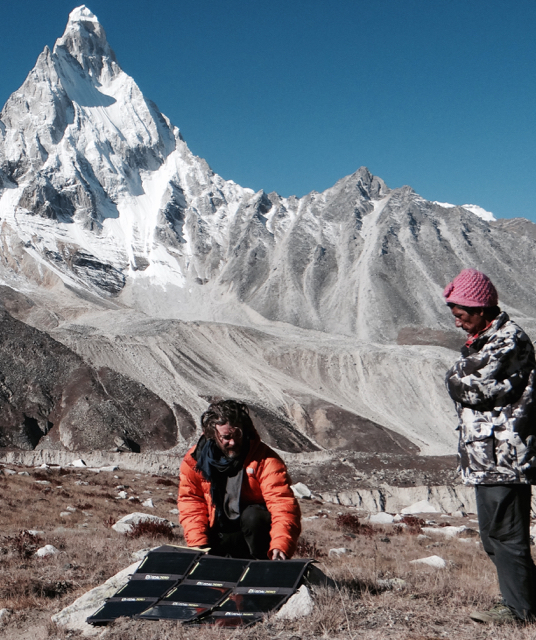
I lay out solar panels while ever-present Berinder waits. Porters would charge their phones and listen to Bollywood music…little luxuries. Photo courtesy of Kapil Negi
As we hit a vertical ropeway, the sun is eaten up by a surging cloud bank coming from the northeast, and there pops up Saurabh smiles as he quickly rappels down to us in a couple of easy springs. He shakes his head at the notion of continuing further, looking up at the sky’s energy. He mentions too that his sense is that “two storms are coming together”, looking down valley. Another cloud front is being whipped behind us in a froth as it moves towards the storm ahead of us. The two are set to join up it seems.
Berinder hasn’t changed…and he will follow us both (not one, but both) anywhere. Somewhere, there is a rumble that shakes everything briefly. Though it feels as though it is deep within the earth itself, it is from the ‘earth above’, the mountains. We turn our heads upwards. Now the snow is beginning to fall, and then it stops and at present all things are in flux.
When we hit camp, Kapil and Bishan have turned up and tea is had while snow does finally start to come in earnest. The snow and wind are taking the day – our last – and imposing a curtain upon it. Sightlines are brought in from tens of kilometres into a short span of just metres. Flakes like leaves shoot diagonally as the ‘second’ storm from far up the greater Gangotri Glacier takes our entire camp into its arms.
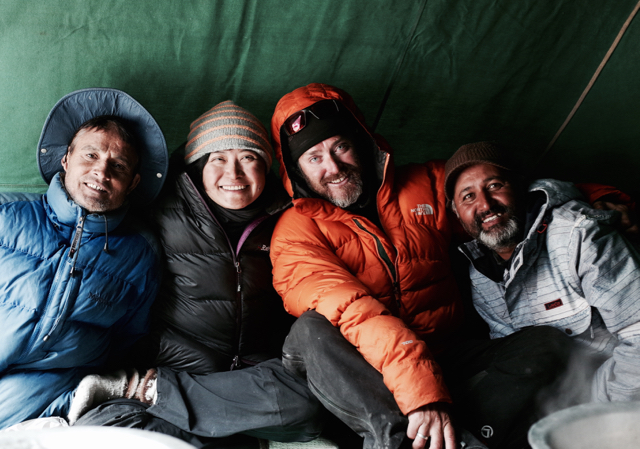
left to right: Bishan, Debra, myself, and Kapil in a moment of tea-inspired warmth in Karma’s divine tent
Friend Kapil and his story-telling and compassion for the mountains are welcome and the tea begins to flow as we all stuff ourselves into the famed kitchen tent. Karma is like a proud grandmother with all of her flock around her. Deb has spent part of the day learning recipes from Karma and Karma has the glow of someone greatly appreciated. I sit half in and half out of the tent in a little fold-out chair.
Inevitably the conversations turn to the health of the mountains (as they so often do). One cannot spend any amount of time within these bastions without being blitzed with worry about the intense change brought on by distant forces. Locals never seem to need nor see much data but they can tell a story about a fading glacier’s range, they can show a photo on their little Nokia phones taken a few years ago of a very different snowline.

Saurabh and I before Chaturangi Glacier’s mouth. Photo courtesy of Kapil Negi
Many forces are already in play in conversations about the mountains. Temperature change, fading ice, lakes that swell and threaten centuries old communities….much is needed to combat what many say is inevitable. What stuns me constantly is how rarely mountain people themselves are consulted about their own very specialized habitats and geographies. Intuitive, completely invested, and wise (though perhaps not ‘formally educated’) it is they who have much of the know-how and tales about what is needed to care for these water towers we call the Himalayas. It is their existence that is inextricably linked to the health of the ‘hills’.

A little snow action while we take tea. Photo courtesy of Kapil Negi
Within the tent, cups of tea in hand there is already discussions about the next journey back. Tomorrow we descend and with that descent comes all of the inevitable worry, warmth, and wonder that last days in the hills bring.
We will move through those huge stones lugging our packs, past the shredded ice wall that is Gomukh and past the disintegrating caves of cold.

Berinder



